- Home
- Aaron Allston
Terminator 3--Terminator Hunt Page 8
Terminator 3--Terminator Hunt Read online
Page 8
“Boys and girls, let me introduce you to the real Ginger and Ripper. And this is their mistress, Kyla Connor. Kyla, you make a great show-and-tell.”
“Hi,” Brandon said.
Kyla gave him a smile. “Hi.” Then she turned her attention to Paul. “A word with you?”
He rose and moved to her. “I’m in trouble now,” he stage-whispered to the kids, offering them a caricatured expression of fear, and several of them laughed.
And the clowning successfully covered for the unease he felt. If his superiors were going to assign him work, they wouldn’t send someone as important—someone who had very specialized security functions—as Kyla to bring him the news.
At the door, Kyla lowered her voice so the kids would not hear. “You’re needed in the inner council’s vehicle depot for a conference. Right now.”
“I don’t even know where that is. It’s topside, right?”
“Nearly. I’ll show you.”
“I shouldn’t leave the kids alone—”
“The other teacher, what’s-her-name, the very pregnant one, told me where you were. She’s wrapping up what she’s doing and will be here to take over in a minute.”
“Right.” Paul stuck his head back in the door. “Kids, I have to go. Don’t anyone leave the room. Mrs. Edwards will be back in a minute.”
A barrage of “Awww” protests, from those who wanted to hear the rest of his story, followed them as they headed down the corridor.
Kyla shook her head. “Ginger and Ripper stories, huh?”
“Well, today’s lesson was supposed to be about the use of dogs. What they do for us, the kind of training they get, all that sort of stuff.” Paul shrugged. “I just sort of thought I’d personalize it a little.”
“Not a bad idea, I guess. How does the story end?”
“Happily. They knock a beat-up old T-600 into a river. It gets swept over the falls, is smashed to pieces on the rocks below, and rusts.”
Kyla snorted, then leaned over to scratch the ruff of Ginger’s neck. “Smart doggie.”
Ginger cocked an eyebrow at her.
* * *
The Los Angeles River had long been anything but. It was an endless stretch of parched concrete, a broad incision across the old city. In the months after Judgment Day, as the Resistance truly began to coalesce, a far-sighted civil engineer named Shawna Norris had led crews that caused authentic-looking landfalls at strategic locations along the storm-drain system, had opened up sections that had been blocked off by genuine collapses, and had gradually transformed dozens of portions of the old system into widely separated, well-hidden hiding-holes. Bone cancer had claimed Shawna Norris’s life only a few years after Judgment Day, as it did with so many people who worked in the radiation-drenched blast zones of Los Angeles, but she was memorialized in the storm-drain habitat that bore her name.
And it was in Norris Compound that the vehicle depot used by John Connor’s advisory staff was located. The depot had once been a convergence of several storm drains, each large enough to accommodate an Army truck. Now it held two such trucks, John Connor’s personal Humvee, a tanker truck painted to look from a sufficient distance like a wreck, a dune buggy, two Jeeps nearly a century old, various pickup trucks and SUVs, and a pair of motorcycles.
Arriving with the escort of two dogs and a teenage sniper, Paul looked wistfully at the motorcycles. He’d had one, up until his capture and presumed death. He’d meticulously built it over a span of years, from parts scavenged under dangerous circumstances from junkyards and ruined repair shops, and had converted it to run on methane, which he could trade for far more easily than he could for rare and precious gasoline or for a precious fuel-cell engine that would better serve elsewhere. He suspected that his cycle had been destroyed by the missile attack that was supposed to have claimed his life.
The depot was also occupied by people—two dozen at least. Some were mechanics, doing hurried maintenance on the Humvee, both of the dune buggies, one of the SUVs, and one of the two-and-a-half-ton trucks. The Hell-Hounds were among those in the chamber, Glitch standing with them, apparently fully repaired and restored. Nearby were several of the senior advisers and members of the Scalpers, another unit in charge of protecting John Connor and carrying out special missions. The concrete walls echoed hollowly with conversation.
Paul whistled. Whatever was going on here, it was a major operation—the senior staff didn’t commit so many precious vehicular resources to scouting operations.
As Paul and Kyla reached the Hell-Hounds, Ten Zimmerman whistled. A few yards away, John Connor straightened from under the hood of the Humvee. “Is that everyone?” John asked.
Ten nodded. “Everyone’s here.”
“Good.” John stepped back from the vehicle’s engine compartment and wiped his hands on a grease-streaked blue rag. “All right, before we get started, I have some good news. Guitar Compound’s factory is coming on-line. We’ve received an initial shipment of plasma rifle battery packs, and they’ve tested fine. That’s why I’ve asked you to bring your full spread of weapons—we’ve got enough juice again to fry some machines.”
That yielded shouts of approval and applause. Even Paul joined in. As the Resistance’s supply of rifle batteries had dwindled over the last several months, front-line fighters and special operatives had been forced to rely increasingly on older technologies. Most slug-throwers, Kyla’s rifle excepted, were insufficient to do real damage to assault robots, and man-pack missiles such as rocket-propelled grenades were too bulky for anyone to carry a good supply. This news promised a return to more aggressive field operations, more successful confrontations with the machines.
“When we’re done here, talk to our quartermaster to get your share,” John said. “Now, some of you know what’s going on here. You can take a nap or do one more obsessive-compulsive weapons check. The rest of you, listen up. Or, rather, listen to Kate, since this operation is her plan.”
Leaning against the Army truck, Kate offered her husband a mock scowl. “Only the good parts. The really foolish parts are your contribution.”
Paul tried to keep from gaping. Under every other circumstance in which he’d had the opportunity to see John Connor and Kate Brewster, they’d been focused, steely-eyed leaders brimming with confidence. Here, in the presence of their bodyguard details and other special operatives, they seemed looser, more humorous, less fiery. It was a strange change.
John didn’t reply to his wife’s dig. He just gestured for her to continue.
With a sigh, Kate straightened and began. “There’s a T-X Terminator out there. Very few of us have seen one. Everyone who has done so and lived is now in this chamber, in fact. The T-X has some of the chameleon abilities of the T-1000—as far as simulating human beings is concerned, it has all the disguise potential of the T-1000—and it’s a lot more destructive.
“We think it’s been prepared for a time jump to eliminate John in the past. Unlike our previous experiences with Skynet’s time-related operations, we don’t think we can head it off when it gets there. This means we can’t counter its plans. So we’re going to have to force Skynet’s hand and convince Skynet to send it after John in the here and now.”
That caused some muttering.
“This operation is in two parts,” Kate continued. “The bait portion and the hook portion. The bait portion is to be conducted by the Scalpers. They’ll be traveling to Clover Compound in Colorado.”
Someone whistled. Clover Compound was a tough place. It was the Resistance habitat situated closest to the Navajo Mountain Strategic Region. At the heart of the region, built deep beneath the earth, was Navajo Mountain, the center of Skynet activities. The mortality rate among the inhabitants of Clover Compound, even among couriers and supply-runners visiting the region, was high.
“The reason,” John said, “is because we think Clover has been compromised. We recently did some looking for any compound or habitat that had a higher-than-statistically-likely failure rate
, and Clover was at the very top at the list, even allowing for its proximity to Skynet. We have no reason to suspect incompetence or deliberate collaboration with the enemy. To us, this means there’s a security leak.”
“And before we close that leak,” Kate continued, “we’re going to use it. At Clover the Scalpers will let it be known that John is looking for a specific woman and that this woman is going to be brought into John’s presence the instant she’s found. Our belief is that Skynet can’t pass up this opportunity to kill John, that it will dispatch the T-X to impersonate the woman. The Scalpers will have to conduct her into John’s presence.”
Paul saw a small group of the soldiers, standing together, exchange unhappy glances. A woman with long hair put two fingers to her temple, as though they were the barrel of a handgun, and mimed pulling the trigger. Paul supposed they were the Scalpers. He wondered what had happened to Crazy Pete and Warthog, the senior members of the Scalpers, the only ones whose faces he knew.
“In the meantime,” John said, “Kate and I are going to be accompanying the Hell-Hounds and a technical crew to a National Guard armory abandoned on Judgment Day. We have reason to believe that this armory is a front for a materiel cache not listed with the pre-J-Day military records, that its complement of vehicles and weapons may be intact. The tech crew will get as many of the vehicles working as is feasible and set them and the arms and munitions stores up for transport … and help rig the armory, or some site near it, as a trap to capture the T-X.”
Silence fell on his last words. Paul looked among the faces present. Some of the technicians and most of the Scalpers were registering surprise. The advisers and Hell-Hounds were not.
“Excuse me, sir.” That was the Asian-American man standing with the Scalpers. “You did say capture.”
John nodded. “That’s the ‘hook’ portion of the mission. We capture the T-X. We need this Terminator, people. If we can capture it intact, reprogram it as we have with the few Terminators we have serving the Resistance, we could achieve a quantum jump in our understanding of Skynet technology, particularly its high-end weapons systems, nanotechnological control systems, and liquid-metal manipulation. Don’t forget that a single infiltration of a T-800 manufacturing plant gave us the information we need to begin cloning animal tissues, as Skynet does to create T-800 skin, and that’s responsible for the increased amount of meat we’ve been receiving in our diets for the last few months. Things we learn from the T-X could be just as important—or more important. It’s an opportunity we can’t let slip by.” He cleared his throat. “If I didn’t think it was that critical, Kate and I wouldn’t be accompanying the Hell-Hounds to act as bait.”
“We begin to stage our exit in ten minutes,” Kate said. “That’s when the advance vehicles depart. Ten minutes later, the remaining vehicles leave. So make your final checks, get your gear loaded on your assigned vehicles.” She turned away from those she addressed, clear sign that the briefing was done, and marched over to John’s side.
A suspicion began to whirl around in Paul’s mind, but he decided to keep it to himself, at least until he could better make out what it meant. He turned to Ten. “Uh, I don’t have any gear to load.”
“Sure you do.” Ten glanced over at the unit’s T-850. “Glitch.”
The Terminator shucked a backpack and shoved it to Paul. It connected with Paul’s torso with enough force to send him staggering back a step. “Clothes,” Glitch said, in the approximately German accent that seemed to come standard with the programming of all the old T-801s. “Minimal camping gear. Cold weather gear. Preserved food supplies. First-aid gear.”
Paul took the pack and swung its straps over one shoulder. “Weapons?”
“Camp knife,” the Terminator said.
“No firearms to spare, sorry,” Ten said. “You’re in the back of the big truck.”
“Thanks.” Paul lugged his pack to the rear of the truck and clambered up. The forward portion of the bed was heavily packed with crates, all of them lashed down with old dubious-looking hemp ropes. Paul sat down on the left side, adjacent to the crates, and set his pack down beside him, between him and anyone who might sit nearby.
Ten’s words had transformed his suspicion from mere paranoia to a real likelihood.
They were going to kill him.
His few days back in Home Plate had made it clear to him just how much things had changed. He’d always known that he wasn’t well liked, and as word of the circumstances of his incarceration in San Diego had spread, someone had even nicknamed him Sleeps-With-Toasters.
But to send him into the field without a firearm, without an RPG? It meant that he wasn’t being allowed to contribute to the survival of the people he accompanied. He wasn’t trusted. He wasn’t liked well enough for anyone to vouch for him.
He wondered if he ever had been. Making friends had always seemed next to impossible, a mysterious art whose practitioners were never willing to let him in on the secret.
He thought he’d had something those few days he was teaching the children. But that seemed somehow easy. Maybe it was because they weren’t his social equals. He wasn’t facing his peers, so that part of him that clamped up tight whenever he tried to talk to another adult didn’t constrain him.
The bed of the truck creaked and rocked slightly as more people boarded. Glitch sat directly opposite Paul, staring at him. Technicians boarded next, one of them sitting next to Paul; Paul didn’t glance up. Last aboard were Earl and Mark of the Hell-Hounds; they hauled the tailgate up and dogged it in place.
“How’s it going, Keeley?” That was the man who’d sat next to Paul.
Paul finally glanced up. His next-seat neighbor was Tom Carter, a lean, aging Resistance technician. Though only a lieutenant in the armed forces, Tom possessed influence disproportionate to his rank; he did much of the restoration, upgrading, and reprogramming of Terminators captured by the Resistance and would probably land on John Connor’s advisory board the instant he decided he didn’t want to do fieldwork anymore. Paul had reported to him on a weekly basis for the two years before Paul’s capture. But Tom had never stopped in to see how Paul was faring after his return from the San Diego hospital.
How’s it going? Once, Paul would have said, “Fine, just fine.” It’s what he always said. It was an answer that discouraged further questions, further conversation. It was—and had always been—a convenient lie.
Well, he had no interest in conveniencing other people, especially if they were going to kill him soon.
“Not so good,” he said and turned away.
The truck’s engine whined for several long moments, then caught and held with a not-too-unhealthy rattle. Moments later, they were in motion.
PART 2: OPERATION FISHHOOK
c.6
Near Clover Compound, Colorado
The Resistance both loved and hated the Rocky Mountains.
The love wasn’t because of the region’s scenic beauty, although that was undiminished from the years before Judgment Day—other than in large cities, most of which had had nuclear missiles slapped down upon them and now existed chiefly as fire-blackened craters. It was instead the fact that the terrain hampered Skynet activities.
The mountain broke sight lines, making it more difficult for Skynet forces to observe human movements and operations. With many places, valleys and ravines especially, spy satellites or aircraft had to be directly overhead to be able to witness such activity at all, and had to cover so much territory with their passes that they often saw nothing. The mountain slopes were ideal positions for human observers and for setting up ambushes.
It was in the Rockies that the Resistance had its first military successes, in those few years after Judgment Day. Tough men and women had come spilling out of the mountains, launching fast, deadly raids on Skynet-held armories, blowing up robot-making factories, fleeing back into the relative safety of the natural castles of stone.
There was even fresh food to be had, not the hydroponically
grown stuff that kept the Resistance alive, but meat. Bow hunters sometimes crept out of their compounds and returned with deer, sheep, goats, even elk, and were treated like heroes by those they fed.
The hatred for the mountains—well, that was natural, too. West of Colorado Springs, near Pikes Peak, was Navajo Mountain. From that deep-buried citadel Skynet had, since Judgment Day, executed plan after plan to exterminate the human race. And the closer one went to Navajo Mountain, the more dangerous the mountains were. Assault robots waited in the machine equivalent of hunters’ blinds. Lethal flying machines patrolled the skies. Spy satellites minutely scrutinized every change to ground detail.
It was in this region, northwest of the ruins of Boulder, that Chris Sato had grown up. His parents had run a sporting goods store in Boulder before J-Day. When the first, garbled reports had come over the radios, heralding the end of the world, the Satos had gathered their three children and a tremendous amount of gear from their store, then had fled to a cabin they owned on a hunting lease deep in the mountains. There, Sato and his two sisters had grown into their teenage years, learning to hunt with guns and with more silent weapons, to hide, to evaluate the occasional fellow humans they encountered.
Eventually, Sato’s father broke a leg in a fall and began to succumb to persistent fevers. Then, finally, Sato’s mother had accepted an invitation from someone who’d dwelled one valley over to join a community that had organized within an abandoned mine. Cared for by that compound’s medics, Sato’s father had survived, and the compound itself had soon joined the growing Resistance led by John Connor. He and his sisters had had instant status with the compound; though young teenagers, they shot as well as any of its adults, could track better, and could keep a small compound supplied with fresh meat.
Now, more than a decade later, Sato’s parents were still alive, leaders of a compound on Lake Mead in Nevada. His older sister, Angela, married and with three surviving children, was in charge of weapons fabrications at a compound in Washington State; his younger sister, Dana, taught forest skills to the young at a new compound in Louisiana. And Sato, after years demonstrating competence as a security and defensive emplacements expert at compounds all over Nevada and Colorado, had been promoted to rebuild the Scalpers when two-thirds of its members had been wiped out and the remainder were too young and inexperienced to do the job.

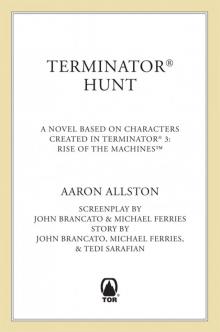 Terminator 3--Terminator Hunt
Terminator 3--Terminator Hunt Mercy Kil
Mercy Kil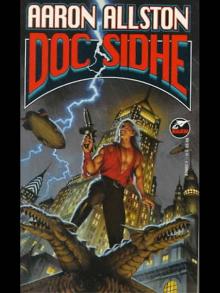 Doc Sidhe
Doc Sidhe Star Wars: Fate of the Jedi: Outcast
Star Wars: Fate of the Jedi: Outcast Fate of the Jedi: Backlash
Fate of the Jedi: Backlash Mercy Kill
Mercy Kill Rebel Stand
Rebel Stand Wraith Squadron
Wraith Squadron Star Wars: X-Wing VII: Solo Command
Star Wars: X-Wing VII: Solo Command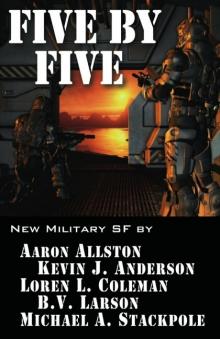 Five by Five
Five by Five Solo Command
Solo Command Star Wars: The Clone Wars Short Stories: The League of Spies
Star Wars: The Clone Wars Short Stories: The League of Spies Sidhe-Devil
Sidhe-Devil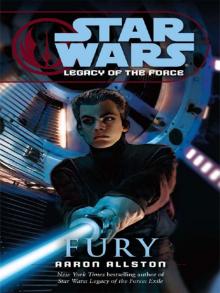 Star Wars: Legacy of the Force: Fury
Star Wars: Legacy of the Force: Fury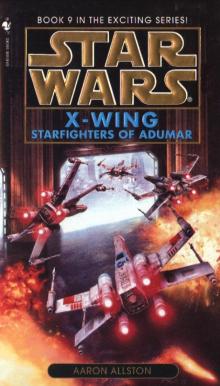 Starfighters of Adumar
Starfighters of Adumar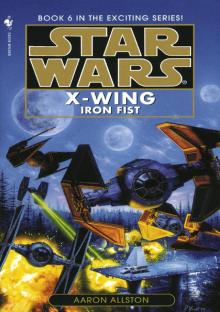 Star Wars: X-Wing VI: Iron Fist
Star Wars: X-Wing VI: Iron Fist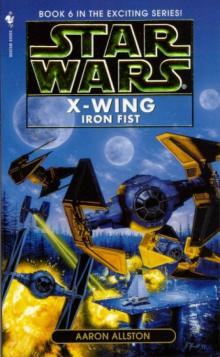 Star Wars - X-Wing - Iron Fist
Star Wars - X-Wing - Iron Fist Exile
Exile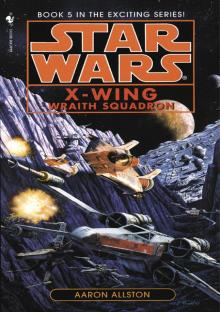 Star Wars: X-Wing V: Wraith Squadron
Star Wars: X-Wing V: Wraith Squadron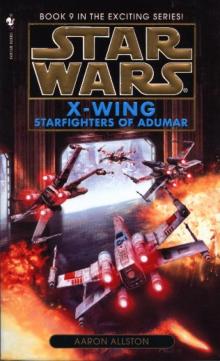 Star Wars - X-Wing - Starfighters of Adumar
Star Wars - X-Wing - Starfighters of Adumar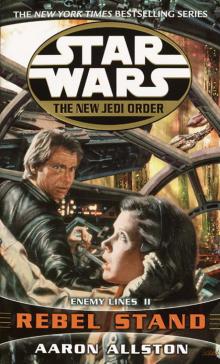 Rebel Stand: Enemy Lines II
Rebel Stand: Enemy Lines II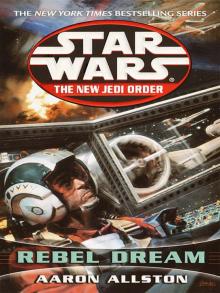 Rebel Dream: Enemy Lines I
Rebel Dream: Enemy Lines I Outcast
Outcast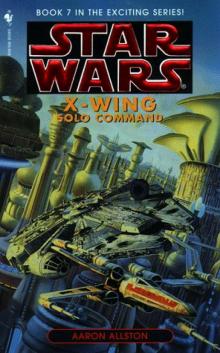 Star Wars - X-Wing 07 - Solo Command
Star Wars - X-Wing 07 - Solo Command